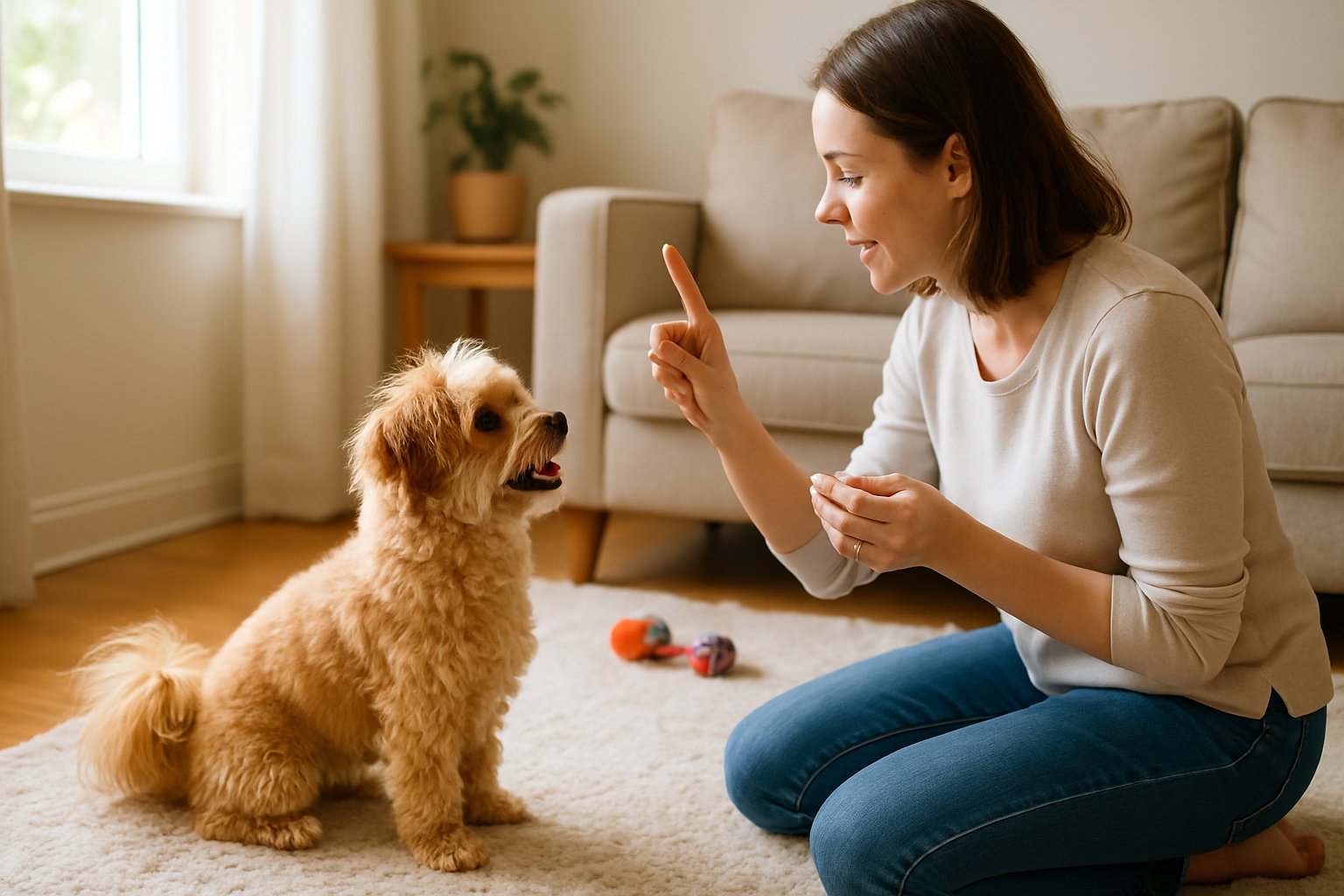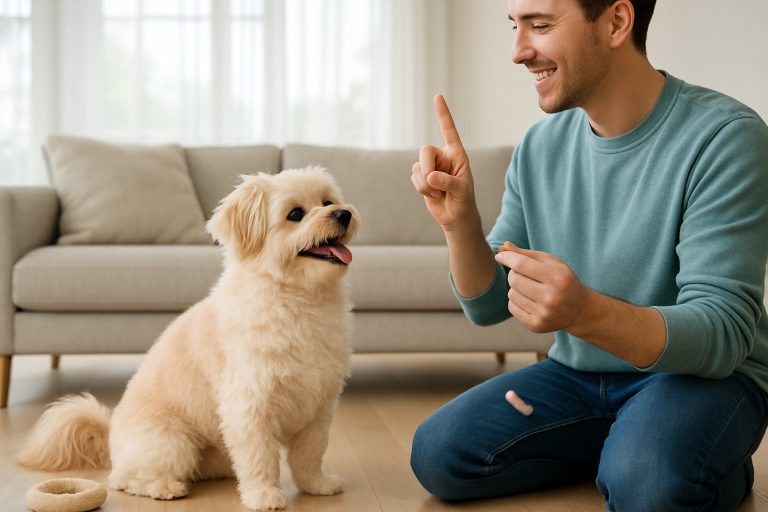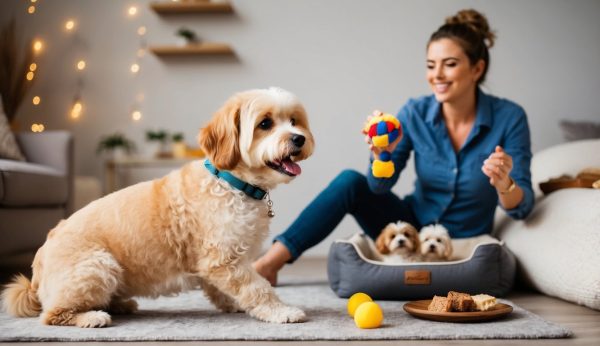Training your Pomapoo can help build a strong bond and create a happy home for both you and your dog. This designer breed, a cross between a Pomeranian and a Poodle, is known for being intelligent, loyal, and full of energy.
Learning basic training strategies is key to making your Pomapoo a well-behaved and enjoyable companion. With patience and the right approach, you can set your Pomapoo up for success right from the start.
1. Start training early to harness your Pomapoo’s intelligence
- Begin training your Pomapoo as soon as you bring them home. Early training helps your dog learn routines and acceptable behaviors right from the start.
- Pomapoos are smart and pick up on new commands quickly. They respond well to simple rules when taught in a calm, consistent manner. Training at a young age helps guide their natural curiosity.
- Your Pomapoo needs socialization along with training. Introduce new people, sounds, and places slowly to help your dog become confident and well-adjusted. Early socialization prevents fear and stress in new situations.
- Using consistent, positive reinforcement, like treats or praise, makes training sessions more effective. Good habits learned early will be easier to maintain as your Pomapoo grows older. For more tips, see this detailed guide to training a Pomapoo.
2. Use positive reinforcement with treats and praise consistently
When training your Pomapoo, reward good behavior as soon as it happens. This helps your dog understand what you want and makes learning new commands easier. Use small treats, verbal praise, or a favorite toy to reinforce positive actions. Most dogs respond well to food rewards, but you can also use petting or playtime if your Pomapoo is less food-motivated.

3. Incorporate short, frequent training sessions to keep them engaged
- Your Pomapoo learns best in short bursts of activity. Plan for each training session to last just 5-10 minutes. Two or three sessions a day helps your dog focus without getting bored or frustrated.
- Puppies and young Pomapoos may need even shorter training times. Try starting with 3-5 minute sessions and increase the length slowly as their attention span grows. This keeps learning fun and avoids stress.
- Mixing in several brief sessions each day helps your Pomapoo remember commands and good behavior. This bite-sized training method keeps your dog alert and motivated.
- Repeating training in different parts of the day gives more chances for practice. Regular, short lessons are more effective than one long and tiring session.
- Be consistent by practicing at the same times each day. Your Pomapoo will come to expect training and get excited to learn with you.
4. Socialize your Pomapoo with other dogs and people early on
- Start socializing your Pomapoo as soon as possible. Early socialization helps your dog feel calm and happy around new people, other dogs, and new places. This can lower the risk of fear or aggression as your Pomapoo grows up.
- Begin by letting your Pomapoo meet friendly dogs in a safe, controlled setting. Watch your dog’s body language and let them take things at their own pace. Always use positive praise and treats to make these first meetings fun.
- Introduce your Pomapoo to a mix of people, including children and adults. Carry out these meetups quietly, avoiding any rough handling or loud noises. This approach builds trust and teaches your dog how to behave politely.
- The goal is for your Pomapoo to handle new experiences without stress. Training and socialization from an early age build a foundation for a friendly and confident dog.
5. Establish a clear potty training schedule with frequent breaks
Set up a simple potty training routine for your Pomapoo to help prevent accidents. Take your dog outside right after eating, waking up, and playing. Younger Pomapoos have small bladders and will need breaks every few hours. Stick to the same spot each time you go outside so your Pomapoo learns where to go. Using the same command and routine every time helps your dog understand what you expect. Be patient and stay consistent with the schedule.
6. Use crate training to provide a safe, comfortable space
- Crate training helps give your Pomapoo a space to relax and feel safe. Dogs like having a small area to call their own, much like a den. A crate can offer comfort, especially when you need to leave the house.
- Start by introducing your Pomapoo to the crate using treats and a calm voice. Let your dog explore the crate without forcing them inside. Try placing a familiar blanket or toy in the crate to make it more inviting.
- Keep crate doors open at first so your Pomapoo can go in and out freely. This helps build trust and prevents fear. Short, positive sessions are best in the beginning.
- Crate training is useful for housebreaking. It also prevents destructive chewing or barking when you are not able to watch your dog closely. For more information about using a crate during training, check out these crate training tips.
- Always use positive reinforcement, like treats and praise, whenever your Pomapoo enters the crate. Never use the crate as a punishment, as this can make your dog anxious about using it. Give your Pomapoo time to adjust and be patient with the process.
7. Teach basic commands like sit, stay, and come before advanced tricks
Start with simple commands like sit, stay, and come before moving on to fun or complicated tricks. These basics are easy for most Pomapoos to learn and help create a strong foundation for all future training. Teaching your Pomapoo to sit helps them learn self-control. It’s a key command that you can use in many situations, like greeting people or waiting for food. Consistent practice with treats and praise makes this skill clear for your dog.
8. Monitor your Pomapoo’s learning style and adapt training methods accordingly
- Pay close attention to how your Pomapoo responds during training sessions. Some Pomapoos pick up commands quickly with treats, while others may prefer praise or playtime as a reward. Notice which method gets the best reaction and encourages your dog to participate.
- If your Pomapoo seems distracted or bored, try changing up the training routine. Short, frequent sessions tend to work better for this breed than longer ones. Switching between toys, treats, or even different locations can help keep your dog interested.
- Every Pomapoo has their own pace and style of learning. Using the same approach for every dog does not always give good results. It can help to use a learning style tool or experiment with different methods to find what matches your Pomapoo’s needs.
- Consistently adapting how you teach will help your Pomapoo feel confident and happy while learning. This also builds a stronger bond and makes training more effective.
9. Avoid long periods of isolation to prevent separation anxiety
Pomapoos can get stressed if they are left alone for too long. This can cause separation anxiety, which often leads to barking, chewing, or accidents indoors. To help your Pomapoo feel secure, try to limit the amount of time they spend by themselves. Gradually build up the time they are alone, starting with short absences and slowly increasing the length as they adjust.

10. Enroll in a professional obedience class if needed
- If your Pomapoo is struggling to pick up commands or you find training difficult, consider signing up for a professional obedience class. Trainers who work with small breeds can help address common issues like barking or stubbornness.
- These classes offer a structured environment for your Pomapoo to learn with other dogs. Group classes also give your dog a safe place to socialize, which can help with confidence and behavior at home.
- A knowledgeable trainer can teach you the right methods and help you handle any training challenges. Some trainers offer private lessons if you prefer a one-on-one setting.
- To find out more about professional training for your Pomapoo, you can check out an expert guide on Pomapoo training and obedience. This resource explains the benefits of enrolling in a class and what to expect when you start.



